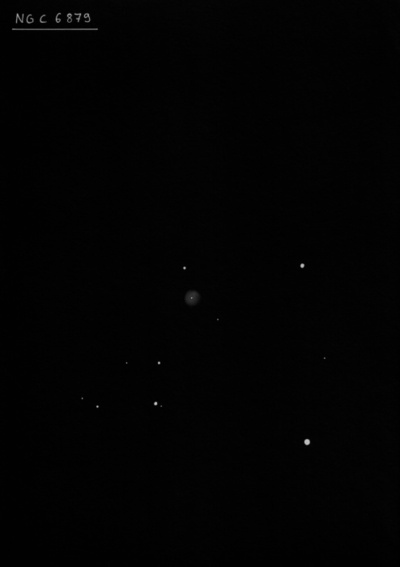
Edward Pickering discovered NGC 6879 = HN 55 on 8 May 1883 using a direct-vision spectroscope with the 15-inch refractor at Harvard College Observatory. The discovery was communicated directly to Dreyer (probably in 1885) and not published until 1908 (Harvard Annals 60). Ralph Copeland independently rediscovered it on 9 Sep 1884 at Dun Echt, Aberdeen using an objective-prism with a 6.1-inch Simms refractor. He remarked "equal in brightness to a star 10.2 mag. Diameter 4.6" by micrometric. It has an 11 mag star at 222.27°, distance 83.2"." His micrometric position in Monthly Notices XLV 2 is very accurate. Both Pickering and Copeland are listed as discoverers in the NGC. Sherburne Burnham described it in 1911 at Yerkes as resembling an out of focus star of of mag 10.7 and he measured a diameter of 3.7".
Based on Crossley photographs at Lick, Curtis (1918) wrote "A minute disk, 5" in diameter, just distinguishable from a star. Fades out slightly at the edges."
300/350mm - 13" (7/85): observation from El Cerrito: stellar planetary at all powers, confirmed by OIII blinking, estimate V = 12.0. A similar mag 12 star is 1.4' SW. Located 14' NE of ∑2634 = 7.9/9.4 at 5".
400/500mm - 17.5" (9/5/99): picked up at 100x with OIII blinking as a mag 12 "star" by star hopping from the double star ∑2634 = 7.9/9.4 at 5" which is 14' SW. A good comparison star for blinking is situated just 1.5' SW. At 280x, the PN has a slight bluish tinge with a "soft" edge. At 380x, a very disc ~4" is resolved with a brighter center. The disc is easier at 500x and a mag 16 star is occasionally visible at the north edge.
600/800mm - 24" (9/2/16): picked up at 200x unfiltered as a slightly soft, pale blue "star". Excellent response to an OIII filter. A slightly brighter 12th mag star is 1.4' SW, though with the filter the planetary dominates this star. Improved view at 286x and 375x. A small 5" disc is easily resolved. Nearby a mag 13.5 star is 50" WNW and a mag 14 star 50" SSE. At 500x, a 15-15.5 mag star is just off the north side (15" separation) and another 15th mag star is 30" SSE. The center is brighter but the seeing wasn't steady enough to resolve the central star.
Notes by Steve Gottlieb